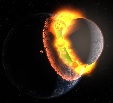|
Water, Clouds, Trees
|
|
| Star_Man | Date: Monday, 07.09.2015, 04:14 | Message # 16 |
|
Observer
Group: Newbies
 United States
United States
Messages: 2
Status: Offline
| Hello all. Quontex, I know what you are saying. It's a good idea but, for Space Engine it would be a much better idea to use a 3D procedural approach. I've been programming for many years, so, I have a good understanding of what's going on in SE. At the end of the day the 3D procedural approach would look much more realistic and, it would follow the flow of the way SE works now. What you are talking about is called the Billboard approach. It is used in many games but, it has a lot of limitations and it is never as realistic looking as the 3D approach. But, the important thing is no matter what method is used it will be so wonderful to see plants and animals in SE.

|
| |
| |
| ursadesign | Date: Sunday, 27.09.2015, 11:43 | Message # 17 |
|
Observer
Group: Newbies
 United Kingdom
United Kingdom
Messages: 7
Status: Offline
| Won't trees be very, very hard to procedural generate? They're quite complex structures
|
| |
| |
| Aerospacefag | Date: Sunday, 27.09.2015, 16:17 | Message # 18 |
 Pioneer
Group: Users
 Russian Federation
Russian Federation
Messages: 401
Status: Offline
| ursadesign, we can always save resources on something else, right now the planetarium mode provides a superior detalization to any known engines, but most of these engines don't need such high quality anyway. Probably they will get there in 3-5 years one way or another, just about time the Space Engine game itself may be released.
The real problem of course is the modeling of the plants and (especially) animals themselves, which a the very debatable question with doubtful outcomes. I've suggested to make some sort of swarms, flocks, packs of different animals, birds and fish, generated mostly by the particle systems, but that's just a half-measure anyway.
|
| |
| |
| ursadesign | Date: Monday, 28.09.2015, 08:54 | Message # 19 |
|
Observer
Group: Newbies
 United Kingdom
United Kingdom
Messages: 7
Status: Offline
| Also, on a more science based note, how would it be determined which planets have trees and where?
|
| |
| |
| lupus | Date: Saturday, 03.10.2015, 08:45 | Message # 20 |
 Observer
Group: Users
 Poland
Poland
Messages: 13
Status: Offline
| I think most Earthlikes with the gravity not exceeding 1,2g would have trees (of course having given enough time to evolve). Especially in lower gravity trees may be spectacular, because they will be higher. Trees are pretty efficient in their biology, so I assume we would see many similar organisms on alien worlds.
|
| |
| |
| sclarinval | Date: Tuesday, 21.06.2016, 16:06 | Message # 21 |
 Astronaut
Group: Users
 Pirate
Pirate
Messages: 41
Status: Offline
| Quote SpaceEngineer (  ) Does anyone know about such algorithms?
I know you said this a while ago, but I thought this could be interesting to you: https://redd.it/1lpaii
|
| |
| |
| Alek | Date: Tuesday, 21.06.2016, 20:30 | Message # 22 |
 Pioneer
Group: Users
 United States
United States
Messages: 326
Status: Offline
| Quote lupus (  ) I think most Earthlikes with the gravity not exceeding 1,2g would have trees
Planets could have trees above that, they'd just look more and more like thick-centered shrubs than what what we'd like to call a tree, but if it has the same biology or similar to our own trees then thats what you should call them (not many bushes have as many levels of fractal-noise-looking branches as trees do--from what I've seen most bushes only have about 3 levels of branching while trees can have many more...this is on average of course)
Living among the stars, I find my way. I grow in strength through knowledge of the space I occupy, until I become the ruler of my own interstellar empire of sorts. Though The world was made for the day, I was made for the night, and thus, the universe itself is within my destiny.
|
| |
| |
| Hornblower | Date: Tuesday, 21.06.2016, 21:32 | Message # 23 |
 World Builder
Group: Users
 United States
United States
Messages: 714
Status: Offline
| Factors like star color and gravity can apply to tree height and color
|
| |
| |
| gamadh | Date: Saturday, 01.10.2016, 19:43 | Message # 24 |
 Observer
Group: Users
 Brazil
Brazil
Messages: 14
Status: Offline
|
Edited by gamadh - Thursday, 27.10.2016, 17:22 |
| |
| |
| truthseeking | Date: Sunday, 02.10.2016, 07:26 | Message # 25 |
|
Observer
Group: Newbies
 Brazil
Brazil
Messages: 1
Status: Offline
| I think you should start adding life textures as simple as possible.
It's easier to debug later on and it's a start for more complex simulations.
Try adding "algae" (autotrophs) in the planet's water (hidrocarbons) bodies. Like a "greener watar" where
on the planet gets more light, has the right temperature or geothermal chemicals. etc...
Make it fading away from the "good" spot to the inhospitable areas where
it will be nonexistent. Later on you could make this "green water" spot with depth also.
Maybe make the whole thing dynamicly changing as the planet's seasons pass by...
As for the calculations for the occupied area of this new biomass:
For planets that have a solvent and autotroph life, calculate the total amount of energy (light intensity, geothermal chemicals etc) the areas of the planet receive (using a standard value) and give a random value for the autotroph efficiency from minimal to survive (covering a small area where the energy is plenty) to 100% efficiency (Very rare with maximum area covered)
Could also be made from the clouds of gas giants with aerial-micro-algae in certain depths\latitudes
That would be so cool 
|
| |
| |
| elfootman | Date: Friday, 07.10.2016, 19:53 | Message # 26 |
|
Observer
Group: Newbies
 Chile
Chile
Messages: 1
Status: Offline
| truthseeking has a very good idea, what about simulating earth like planets with how Earth was billion of years ago? Like when Earth only life was stromatolites, it should be something fairly simple. Add mushroom shaped rocks at coastlines according to some pseudo random algorithm.
Something like Earth's carboniferous era is definitely more complex, but still not a so farfetched idea, given the small amount of plant, and tree species, basically something like this:
https://www.youtube.com/watch?v=FlXZ3zOOLBA
Add placeholder sounds for wind, insects, water, and it should turn out very nice.
Edited by elfootman - Friday, 07.10.2016, 19:55 |
| |
| |
| gamadh | Date: Thursday, 27.10.2016, 17:20 | Message # 27 |
 Observer
Group: Users
 Brazil
Brazil
Messages: 14
Status: Offline
| it would be possible to use a procedural Generation like an star citizen to Generate the terrain In the planets? but to generate completely different and infinite plants and animals is really a mystery
|
| |
| |
| DoctorOfSpace | Date: Thursday, 27.10.2016, 20:33 | Message # 28 |
 Galaxy Architect
Group: Global Moderators
 Pirate
Pirate
Messages: 3600
Status: Offline
| Quote gamadh (  ) it would be possible to use a procedural Generation like an star citizen to Generate the terrain In the planets?
It would definitely be possible, the problem falls under practical for one person.
Intel Core i7-5820K 4.2GHz 6-Core Processor
G.Skill Ripjaws V Series 32GB (4 x 8GB) DDR4-2400 Memory
EVGA GTX 980 Ti SC 6GB
|
| |
| |
| gamadh | Date: Thursday, 03.11.2016, 14:59 | Message # 29 |
 Observer
Group: Users
 Brazil
Brazil
Messages: 14
Status: Offline
| I think you must first add only rocks and plants on the surface of planets, then you can add the rest. by chance there is some algorithm that can constantly change the objects in the universe? like an carboniferus
Edited by gamadh - Thursday, 03.11.2016, 15:12 |
| |
| |
| cristobal_leal | Date: Wednesday, 09.11.2016, 21:18 | Message # 30 |
 Observer
Group: Users
 Pirate
Pirate
Messages: 14
Status: Offline
| In my opinion, is a priority to do a better surface and bottom sea. Actually is so ugly and unrealistic. The clouds is important too, and the trees would be cool. But the surface and bottom of the sea is the most important, i think.
Look the picture. Is ugly explore the oceanic planets. Because the sea and the atmosfera have fails.
|
| |
| |